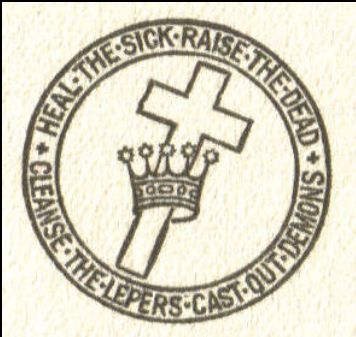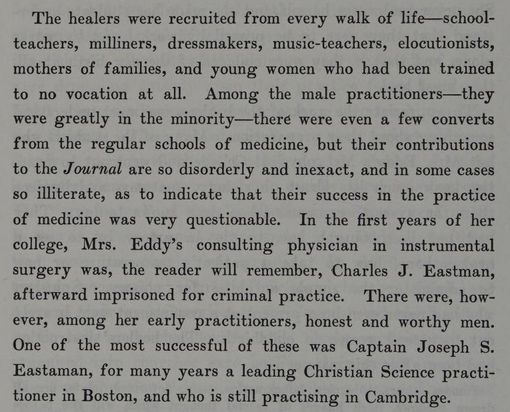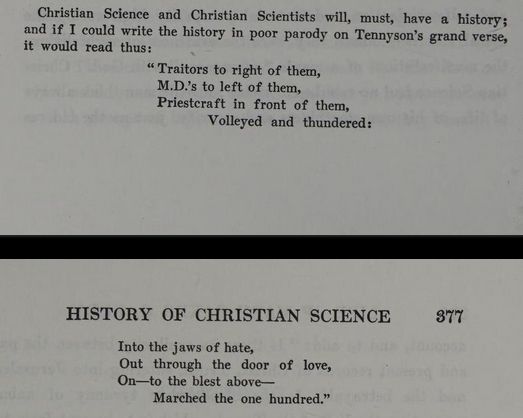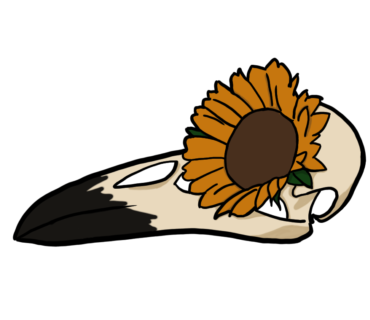
In the last episode of Mary Eddy, we briefly touched on the foundation of the Church of Christ, Scientist. As a brief recap, in 1875 is when we see the first mention of Christian Scientists being used to describe the collection of Mary’s ardent believers. Daniel Spofford, George Barry, and Elizabeth Newhall were among the first eight members that were appointed leaders of this new organization and were tasked with finding a suitable meeting hall for them to meet in.
Having done so, they began establishing the Christian Science Association. By 1876 they officially adopted the name and began holding informal meetings. It still wouldn’t be until 1879 when they would officially charter themselves as a church under the name Church of Christ, Scientist. By this point, the original three members who had helped kick off the organization had either left or were kicked out in the case of Spofford.
That should catch us up with what we discussed last time, at least as it relates to the history of Christian Science. We’re going to pick up from this point and move forward with, essentially, the latter half of Mary’s life. Brief reminder: Most of this history comes from The Life of Mary Baker G Eddy, the most critical and thorough document I found.
It’s worth mentioning that official Christian Science publications are known to have a positive slant. This isn’t to say they aren’t accurate in some capacity. It’s possible to be biased and still get basic information correct.
I also encourage you to go read from official church sources and come to your own conclusions. I include several in the references section of this post, all available for free on the Internet Archive.
All that said and out of the way, let’s get back into Mary…I mean the Church’s story.
Thanks to Mary’s growing paranoia of malicious animal magnetism, most of the early Christian Science meetings were held in secret. She genuinely believed that Spofford and Kennedy’s thoughts alone would derail and kill the church’s chances of ever getting off the ground. Another reminder: malicious animal magnetism is the same thing as mesmerism, according to Mary, and I will be using the terms interchangeably during the article.
Finally, in August of 1879 the charter would be signed, notarized, and recognized. In all, 26 members were officially recognized on the charter. It’s speculated that a fair few of these members may not have been active within the original Christian Science Association.
Fun side note, it was said that Mary had all of the people attending the notarization take different routes to the notary’s office. This, big surprise here, was to throw off the scent of the mesmerists. They also specifically hired a notary who one of the officers – Margaret Dunshee – personally vouched had no contact with any known mesmerists (read: Spofford or Kennedy.)
For the first year and a half, roughly, the church would meet at different member’s homes around Lynn and Boston, MA. Early meeting minutes show that, on average, usually six or so members were in attendance. Meetings typically were conducted in the same way:
- An opening silent prayer or Mary’s interpretation of the Lord’s Prayer (the classic “Our father, hallowed be thy name”)
- One of the members would read from Science and Health
- Another member would then read from the Scriptures before wrapping up services.
There are some records of Mary giving talks, when she was in attendance, but overall the above was how most meetings were conducted. To this day, this is largely how services are conducted, with the only additions being some hymns or testimonial time. There are now two service days, Sundays and Wednesdays, though some churches have chosen Wednesdays as their service days due to declining attendance.

Though these meetings would continue on for awhile in Lynn, eventually attitudes about the town turned against the Christian Scientists. Unsurprisingly, Mary attributed this shift in attitude to Spofford and Kennedy. Thankfully, the group had already been holding more and more classes in Boston, having finally rented a space that they could meet in.
However, it seemed that Mary wasn’t content to just stay in Massachusets.
She and Buswell, one of the original directors of the church, got out a map and decided that Cincinnati, OH was going to be the next spot they tried to expand the church to. Why there? There were plenty of train lines that ended up in Cinci.
Buswell went alone, ahead of Mary, who said that she would join him in six weeks time. Hopefully, by now, you’ve come to realize that Mary rarely follows-through on her promises to others.
She sent Buswell out, on his own dime, to start a new chapter in Cincinnati. After six weeks, when she didn’t join him, he wrote to her to request more funds and…she didn’t take that too well. In her reply to him, she said that the forces of mesmerism were all over Cincinnati and that they had clearly inspired him with “disloyal sentiments.” All over him needing money to start her church…
Boston, on the other hand, was taking off. Mary’s students there – Arens among them – began teaching her methods and holding meetings. Still, there were rumblings among her most devout early followers that things with the church weren’t all they were cracked up to be.
As I mentioned in the last episode on Mary, there were eight original members that in 1881 would resign from their positions. Between Mary’s outbursts about mesmerists, the lawsuits the church was always in, and the disdain for the church the lawsuits had generated; they were tired. Though they tried to talk to Mary about all of this, once they were all equally resolved, together they drew up a document of resignation and left all at once.
This document was read at a meeting and caught Mary by complete surprise. The meeting apparently lasted till well past midnight because it was so heated. Mary claimed that the resigning members were all victims of mesmerism, yet still went to each of their houses the next day, possibly to try and convince them otherwise. All of them kept their doors closed to her.
Further, Mary basically refused to let these members resign. In a petulant move, she instead decided that they were to be expelled. She told them they had to appear in church in October, none of them came, and in this fit two more members resigned.
Behind the scenes to all of this drama, Buswell and one other member quietly resigned as well.
Defeated in Lynn, Mary would move to Boston for awhile in 1882. A year prior to her move is when the Massachusets Metaphysical College would be established.
As I mentioned in the previous episode, this “college” was little more than a Mary fan club. There was never really a proper building for it, it largely just existed wherever Mary was. The degrees they handed out weren’t even real degrees.
What she taught there was the same thing she had been teaching the whole time. The only difference was an increased focus on anti-mesmerism. Tuition was raised to $300, though if a student could pay, Mary would happily accept only $100. It wouldn’t be until the spring of 1882 that the Eddy’s would buy a home in Boston and affix a plate to the door that established their home as the Massachusets Metaphysical College.
Shortly after this time is when Asa would pass. We wont get into that section of things, but I do cover it and the fallout between Mary and Arens in the Mary Eddy Part 2 article. It’s a wild tale and, if you haven’t already read it, I definitely advise you to go back to that part at least.
I’d also like to remind you that back in the New Thought episode we talked about Emma Curtis Hopkins, who lived at this “college”. Maybe now that puts into context what getting kicked out of the group meant.
The Metaphysical College was run in a semi-cooperative style where, theoretically, everyone shared in expenses for the house. They had one room to practice their “medicine” in and observed a set shift rotation so that only this one room would be in use. Of course, Mary would also continue to host classes here.
The picture that was painted of life inside the college was not always the most friendly.
Not only were students kept so busy they rarely had time to socialize with one another, but the specter of malicious animal magnetism was always a threat in the house. As we saw in the case of Emma Hopkins, those that challenged Mary’s obsession with the topic were kicked out or denounced as mesmerists.
To put it lightly, Mary expected obedience in her college. When she summoned, students would come running to attend to her needs. Malicious animal magnetism was ever present and if students didn’t respond with the same alarm as Mary, there was a risk of them losing their home.
We wont get further into the kind of treatment they experienced in those early days of the Metaphysical College, but it does help paint a picture of the kind of organization Mary had hoped to run.
During the years of 1882 to 1885 the concept of Christian Science would see an increase in students and practitioners. As students learned and completed their “coursework” they would go on to open their own practices, thus increasing the spread of the church. They would be given degrees upon completion and this only lent an air of credibility to what the Metaphysical College taught, despite none of these degrees being anything more than just paper. These students would then direct their students to attend the main lecture series Mary taught, those student’s students would go out into the world afterwards, and rinse and repeat.

This would also garner attention from other denominations as the church began to gain traction.
Most simply denounced her ideas as silly nonsense, though some would warn that following this set of ideas went against the establishment. Mary would use this as a way to claim persecution, decrying the way that male pastors would attack her beliefs. Though she had done little work for the cause, she and the church were all too happy to paint her as a long suffering feminist whose ideas should be taken as serious theology. She would often take to the Boston newspapers or the Christian Science Journal to defend against these detractors with fire and brimstone.
It is important to note, however, that pastoring was not a traditionally female profession. So, yes, in some ways it is fair to say that Mary was a feminist pioneer at a time when women usually held few working positions, let alone religious ones. That, however, does not put her in league with those that were leading the charge for equal treatment of women.

By the late 1880’s, things had picked up immensely for the church. So much so that they were beginning to discuss a permanent church building. Land would be purchased, fairs and fundraisers held, and eventually Mary would move house yet again.
So, let’s end on that high note, because things are about to get strange from here. As if they haven’t already been a little odd this whole time. We’ll pick up next time on an emerging battle between the Mary loyalists and the group that would become New Thought.
As always, if you’ve enjoyed following along, let me know! I love to hear your thoughts on all this. Additionally, please share with your friends or anyone who might be interested. Sharing is caring, or so they taught me as a kid.
Until next time, stay safe and sane out there!

Leave a Reply
Only people in my network can comment.